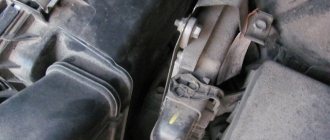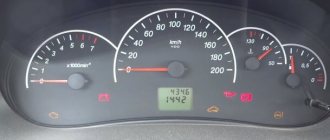VAZ 2110
Today, high gas consumption of the VAZ 2110 is a fairly common problem among car owners. High gasoline consumption for a VAZ 2110 can occur for various reasons. However, before you “treat” the car, it is worth finding what is causing the car to function poorly. Indeed, if a car begins to overuse fuel, then this is bad, as undesirable consequences may appear.
Why does the consumption exceed the passport values?
Consumption exceeding the passport figures is fraught with reasons, often interrelated. This automobile disease can be identified by diagnosing its operational parameters, technical condition, and external factors:
- Dark exhaust, loud pops from the muffler.
Based on 100 km of travel, additional losses are also tied to engine displacement and the number of valves.
Sequence of diagnostic work
Before intending to bring consumption to factory values, it is advisable to narrow the range of reasons, starting with electronic, fuel systems, sensors, filters.
The sequence of inspection stages for the VAZ-2110 includes:
- Removing and cleaning the fuel pump diaphragm.
Clean the fuel pump diaphragm and change the mesh
Cleaning the injector nozzles
Adjusting the thermal clearance of the valves
Checking the speed device
Changing the oxygen sensor
Sources of increased consumption on the VAZ-2110
The source of increased flow is often:
- Air filter, integrity of high-voltage wires, weak spark plug.
- Clogged injectors.
- Malfunction of spark plugs, air consumption sensor, excess pressure in the fuel system.
- Defective camshaft fixation sensor.
- Malfunction of the regulator (idle speed).
- Defect (burnout) of one of the exhaust valves or several.
Fuel consumption may increase due to exhaust valve burnout
Low compression can cause increased fuel consumption
The cause may be problems associated with external operating factors, for example:
- Cabin air conditioning, the consumption of which within the city is 10÷20% of total consumption.
- Frequent gear changes.
- Low tire pressure (negatively affects the handling of the car), wide-profile tires, spoilers, low-beam headlights, external trunk, interior audio system.
The trailer helps increase fuel consumption by 10%
To eliminate the causes of increased gasoline consumption, it is more economically feasible to trust a specialized service.
Elimination methods
The mass air flow sensor (MAF) is considered a target device for detecting fuel loss. A machine with the sensor disabled may perform well. This agility is the beginning of the end of the mass air flow sensor. The device is turned out and the voltage is checked with a tester (the ignition is on).
Checking the mass air flow sensor
Based on the individuality of each car, the voltage should not exceed 1.03 V. Otherwise, the sensor is replaced. A VAZ-2110 with a volume of 1.6 liters and a speed of, for example, 2000 requires about 25 kg of air. Therefore, as this value increases, gasoline consumption increases. Hence the priority of diagnosing the air flow sensor.
- A faulty fuel system simultaneously increases the level of harmful emissions into the atmosphere, reduces power, and turns off the engine when idling. The situation requires checking the fuel pressure supplied to the injectors using a pressure gauge (preferably with a 7-fold division range).
Measuring fuel pressure
Overspending is accompanied by:
- Coolant temperature . A defect in this sensor results in a “lean” or “rich” fuel mixture.
- A malfunctioning throttle clamp sensor directly affects the idle speed and throttle response of the vehicle.
The throttle position sensor affects the engine idle speed
Excessive fuel consumption is accompanied by a malfunction of the ignition coil
Excessive fuel consumption depends on many factors, such as timely repairs and vehicle maintenance.
Source
Influence of time of year, temperature and sensor serviceability
Again, a lot depends on the time of year. In winter, every vehicle uses much more fuel. This is due to the long warm-up of the engine, the condition of the road surface, and periodic slipping. In the summer months, the basic consumption rate decreases if you do not keep the windows open when driving at high speeds.
Another reason has to do with the functioning of the sensors. If they are set incorrectly, they will not be able to correctly calculate the sufficient volume of the air-fuel mixture, as required by the engine control unit. This is an oxygen sensor, an air metering sensor and others. As a result, an overly enriched mixture begins to form, which empties the tank in a short time.
The first cars in this series have a carburetor engine, which can be manually adjusted to reduce fuel consumption. It will not be possible to set up an injection engine in the same way. However, it is periodically necessary to look into the injectors of the power unit and check whether they are clogged. If clogged, they begin to spray more gasoline, while the quality of the working mixture remains low.
It is known that the normal temperature of the power unit should be in the range of 90–100 degrees Celsius. As soon as it starts to overheat, the mixture becomes unnecessarily discharged. Engine power immediately drops, which leads to excessive fuel consumption. There is also the concept of “instant fuel consumption,” which is reflected on the trip computer screen. But unfortunately, not all cars are equipped with it. This indicator is influenced by the speed of movement and engine speed. In some cases, it can amount to tens of liters per hundred kilometers, but you should not be afraid of this, since we are talking only about the every second value when accelerating the car in low gears.
With this we will say goodbye. Subscribe to blog updates to continue receiving interesting newsletters. See you again, dear car enthusiasts!
Technical data
It differs in all respects from other models with its improved engine system. According to its parameters, which undoubtedly affect gasoline consumption. VAZ 2110 for 100 km with a 1.5 liter engine and having 71 horsepower, it also has a carburetor power system and a 5-speed manual transmission. With such indicators, its maximum speed is 165 km/h, and its acceleration occurs in 14 seconds to 100 km/h.
| Engine | Consumption (highway) | Consumption (city) | Consumption (mixed cycle) |
| 1.5 (72 l. petrol) 5-mech | 5.5 l/100 km | 9.1 l/100 km | 7.6 l/100 km |
| 1.5i (79 hp petrol) 5-mech | 5.3 l/100 km | 8.6 l/100 km | 7.2 l/100 km |
| 1.6 (80 hp petrol) 5-mech | 6 l/100 km | 10 l/100 km | 7.5 l/100 km |
| 1.6i (89 hp, 131 Nm, petrol) 5-mech | 6.3 l/100 km | 10.1 l/100 km | 7.7 l/100 km |
| 1.5i (92 hp, petrol) 5-mech | 7.1 l/100 km | 9.5 l/100 km | 8.1 l/100 km |
Computer diagnostics of cars
Thanks to this method, you will be able to identify the reasons that lead to high use of gasoline. Sometimes it is impossible to clearly identify them, but the computer shows the entire condition of the car as a whole, as well as the condition of the main parts that directly affect the fuel consumption of the engine.
Greetings to the owners of domestic VAZ "ten", as well as to all those who are now reading these lines! In previous issues we talked a lot about foreign cars (Mitsubishi Lancer 9, Renault Duster, VW Polo sedan, etc.), it’s time to devote a couple of pages to those who support the Russian automobile industry. So, we will talk about the topic: what to do if the fuel consumption of the VAZ 2110 has increased, as well as what it should actually be with proper operation.
Fuel consumption per 100 km for VAZ 2110
All VAZ 2110 models have similar configurations and the same gasoline consumption. On the highway, fuel consumption per 100 km of the VAZ 2110 is 5.5 liters, with a combined cycle no more than 7.6 liters. But if we compare driving a car within the city, the gasoline consumption per 100 km of a VAZ 2110 will be no more than 9.1 liters. In winter, these figures increase to 2 liters.
But the owners of these cars claim that the real fuel consumption for 100 km is as follows:
City - up to 12 l.
Mixed cycle - 9 l.
The manufacturer's table shows fuel consumption figures at idle speed; in reality, they are no different from true gasoline consumption; they amount to approximately 1 liter of liquid fuel.
Why gasoline consumption may increase
This may be due to the following reasons:
- The gas tank was filled with poor quality fuel;
- The driver drives the car and uses aggressive driving techniques;
- Incorrect engine operation.
In winter, the VAZ 2110’s fuel consumption increases due to the fact that first of all the car needs to be warmed up, including not only its engine, but also the interior of the car.
Each owner of a VAZ 2110 car should carry out technical diagnostics to identify any breakdowns in it. This is especially important to do if it begins to consume more gasoline.
Source
What is the fuel consumption of a VAZ-2110 per 100 km?
Nowadays, having a car in your arsenal is considered not a luxury, but an additional convenience.
After all, many car owners can get to work by car, and it’s convenient, simple and easy to bring the harvest from the dacha in their own car. Among the numerous models of domestic cars, the VAZ-2110 is in greatest demand among buyers. When purchasing this model, regardless of the type of engine, which can be either 8 valves or 16 valves, everyone, without exception, is interested in the fuel consumption of the VAZ-2110 car and, of course, the technical characteristics of the iron four-wheeled friend. We will try to analyze these questions further in the article.
Car engine power systems
Any car engine includes a power system, which is responsible for supplying fuel to the engine cylinders and determines its main characteristic - fuel consumption. Regardless of whether the car is diesel or carbureted, the fuel is mixed with air and enters the engine cylinder. Ideally, the amount of air should exceed the amount of fuel.
All power systems are divided into two types - diesel, carburetor and injection. This article will focus on the last two systems. The first is a conventional mechanical fuel supply system, which supplies fuel due to the pressure difference across the float chamber valve system. The second selects the quantity and quality of the fuel mixture based on the readings of various sensors.
The main difference between a carburetor and an injector is that the mixture is supplied in a strictly specified ratio and quantity, which is achieved through many different adjustments. The operation of the injection injection system is completely achieved automatically and is adjusted individually during engine operation for various modes.
Technical specifications
By choosing the VAZ-2110, future owners will have at their disposal a car with improved performance of all systems, without exception, if we compare the “ten” with previous VAZ analogues.
Among the basic technical data, which are not only improved, but also responsible for gasoline consumption, are the following:
- engine capacity 1.5 horsepower;
- carburetor or injector;
- front-wheel drive;
- mechanical type gearbox.
In just 14 seconds, the VAZ-2110 can accelerate to a maximum speed of 165 km/h.
Average gasoline consumption per 100 km
The sensor indicates how much gasoline the car consumes, and this indicator varies depending on the engine type:
- with a 1.5, 72 liter engine. With. consumption in the city is 9 liters, and on the highway – 5.5 liters;
- a car equipped with a 1.6, 89 liter engine. pp., consumes 10 liters in the city, and 6.3 liters on the highway;
- owning a VAZ-2110 with a 1.5, 92 liter engine. pp., motorists should know that a car will consume 9.5 liters per 100 km within the city, and 7.1 liters on the highway.
The optimal fuel consumption per 100 km is considered to be 6.5 liters for any brand of car, if we consider this point from an economic point of view. The average consumption of the VAZ-2110 ranges from 5.5 to 10 liters per 100 km. That is, this indicator is quite acceptable for one of the most popular models of a domestic manufacturer.
What causes increased fuel consumption?
Quite often, VAZ-2110 owners observe that the car begins to consume more fuel. Why consumption becomes high, and what reason can provoke an increased rate of fuel consumption, let’s look at it in more detail:
- A car begins to consume more gasoline if its engine, as they say, is worn out. With prolonged use of a car of any brand, including the VAZ-2110, the piston system wears out, which increases fuel consumption. Many people may ask how to reduce consumption. By replacing the following components:
- worn piston;
- a ring that has become unusable;
- by boring the engine block.
You can independently verify that the piston system has worn out by measuring the compression in the engine with a special tool. The compression rate is indicated in the car's technical passport. If the indicator is underestimated, the above components must be replaced.
- Increased consumption at idle speed can be observed if the air filter becomes unusable. The fact is that a non-working air vent will not be able to get enough air to the engine, so the car will consume more fuel. It is quite simple to understand that the reason for the increased consumption is a failed air vent. To do this, you need to remove this element and examine it in the light. If light does not pass through it, the air filter should simply be replaced with a new one.
- Driving method also affects fuel consumption. If the driver does not start and brake abruptly, and also uses a higher gear at low speed, fuel consumption will be reduced several times.
- Various types of faults in the ignition system can also increase gasoline consumption, for example, dirty spark plugs or faulty wiring. Eliminating the cause on your own without certain skills is not so easy. With this problem, it is best to contact specialists at a service station.
- By activating the air conditioning infrequently, you can save up to 20% on fuel. It is also possible to reduce gasoline consumption if you turn off electricity consumers in a timely manner:
- heated glass;
- interior lighting;
- seat heating system and so on.
Of course, you should not completely abandon the use of electricity consumers, but it is imperative to turn them off in a timely manner.
Taking into account simple, but effective tips and recommendations, each VAZ-2110 owner will be able to independently reduce fuel consumption, which, in turn, will help save a lot of money.
Source
Adjusting the XX mode
Many experts agree that idle speed control is very important for injection systems. In particular, this will eliminate the floating speed, its spontaneous increase or decrease, which will ultimately normalize fuel consumption. As a rule, problems with engine speed in idle mode arise due to excessive air intake. The regulator’s task is to check the regulator, or make changes to the computer, which takes into account the readings of a number of sensors and opens the valve for a certain time, or check the sensors themselves.
This is how the XX adjustment is usually carried out. To begin with, the car's power supply system is de-energized. Then work is carried out with the regulator, which is embedded in the throttle. It is he who is responsible for uniform heating and stable operation of the engine. This is an electric motor with a needle that produces the recommended amount of incoming air, without turning on the throttle.
- The regulator is removed by unscrewing the mounting screws. The latter may not be removable. In this case, you won’t be able to unscrew them; you will have to remove the throttle body.
- Next, the regulator’s tasks include cleaning the regulator channel. It can be washed and then thoroughly blown with compressed air.
- Then you need to disassemble the regulator to get to the guide sleeve.
It is important to know that the regulator should be disassembled extremely carefully. Accuracy is needed primarily because of the sensitive winding of the regulator. It can be easily damaged.
Next you need to do the following.
- Check how the cone needle rotates. If it is loose, then this means only one thing - the bushing needs to be replaced, as there is play. In addition, the cone needle should not show signs of damage or abrasion.
- Then you need to test the integrity of the pressure spring.
- You need to check the contacts and integrity of the winding.
- After assembling the regulator, it must be installed on the car, but before that, measure the distance to the needle. The length should be exactly 23 mm.
- After installing the regulator, you need to connect the control plug to it, and then turn on the power. Having started the engine, you can analyze its functioning at idle and in other modes.











